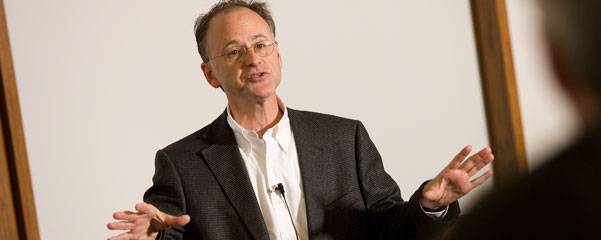What Bank of America Needs Now
Current Bank of America CEO Brian Moynihan is nothing like his predecessor. That’s a good thing, says Professor Syd Finkelstein.

It was a simple email: a few sentences and a link. A former student recently sent a note to Syd Finkelstein, the Steven Roth Professor of Management, reminding him of an article Finkelstein wrote for Forbes.com in March of 2009 titled, “Why Ken Lewis Destroyed Bank of America.”
In that article, Finkelstein deconstructed Lewis’ poor decisions to acquire Countrywide Financial (false sense of value) and Merrill Lynch (bragging rights), and concluded with an ominous prediction: “What’s next for Lewis and Bank of America? It’s almost a foregone conclusion that he will be forced to resign as CEO…The decade of the 2000s, the Ken Lewis decade at Bank of America, will likely end with the company’s breakup,” he wrote, “and with the continued involvement of all of us, the taxpayers, in picking up the pieces.”
Well, score one for Finkelstein. In April 2009, the company’s shareholders voted to strip Lewis of his title as Chairman of the Board and, by the end of the year, promoted Brian Moynihan to CEO. Then, a few weeks ago, Moynihan announced his plan to lay off 30,000 employees and “restructure” the company to save $5 billion. The news came as Bank of America was mired deeper into multi-billion dollar lawsuits and losses stemming from the crash in the real estate market.
Make no mistake, Bank of America is not going bankrupt—it holds over $2 trillion in assets—but there’s no telling when its liability for pushing toxic mortgage securities will end, or how much more it will cost. “The issue that has Wall Street freaked out now,” says Finkelstein, “is that it’s unclear how deep the font of disaster is going to be. And it’s the uncertainty that kills you.”
Bank of America’s current woes are widely attributed to Lewis, by all accounts an overbearing CEO with a chip on his shoulder; someone who longed to live up to his mentor, Hugh McColl, and exact revenge on the prestigious Wall Street cabal who looked down their noses at this banker from North Carolina. In a way, Lewis embodied the age of excess that he presided over, engineering Bank of America’s transformation from a regional entity to a global supermarket of financial services.
Now that era is over, and fiscal austerity is the name of the game. So it’s fitting that Moynihan has been tasked with shrinking Bank of America to a more manageable size. “He’s a grind-it-out type of guy,” Finkelstein says of Moynihan, who played rugby at Brown University and got his start in the legal department at Fleet Boston Financial. “He’s not afraid to work day and night; he’s very sincere and not flashy. He’s different than a lot of other bankers, which I think is good.”
But Bank of America needs more than a hard worker, Finkelstein asserts. “You also need someone who has some humility, not the imperial CEO approach, which was Lewis’ thing. You need someone who can face up to the reality of how bad the situation is.” Moynihan appears to be doing well in this regard, as evidenced by his unpopular but necessary move to lay off so many workers, and his plea to Warren Buffet that resulted in a $5-billion cash infusion.
Another good thing about Moynihan is that Bank of America is not his life’s work. As a rule, says Finkelstein, it’s easier for someone who comes in after the fact to tear down the building that was created by the predecessor. This was the case with Merrill Lynch during the financial crisis, when John Thain was CEO. Thain was an outsider, a Goldman Sachs man. He was removed enough to see the benefit of selling the firm to Bank of America, something that would have been considered sacrilege to a career Merrill Lynch executive, even though it saved the company from an ignominious end. Likewise, “Moynihan is unafraid to dismantle the empire,” Finkelstein says. “If Lewis were the CEO, I couldn’t imagine that happening.”
Moynihan, however, is far from the ideal CEO for Bank of America. For example, he doesn’t appear to be a great communicator. When a company is going through tough times, says Finkelstein, it’s important for the CEO to keep the public informed and at ease. “You need someone who can convey a sense of confidence to the markets, to employees, and to customers; to say, ‘We’ve got a problem, but we’re figuring it out.’ I don’t think that’s one of his strong suits.” Along the same lines, Moynihan reneged on his promise to raise the dividend. “That was a big mistake,” Finkelstein says. “You can’t promise something like that to the market and then not deliver. It starts to break down the confidence people have in your leadership.” Maybe the biggest question mark about Moynihan is whether he can overcome the deficiencies of a resume that lacks, until now, CEO experience. “Does he have the gravitas and gumption to turn the ship around?” Finkelstein asks. The jury’s out.
Which gets to the oft-overlooked issue of trust in banks, something illustrated timelessly in the 1946 film, “It’s a Wonderful Life.” While Finkelstein believes Moynihan is putting Bank of America on the right track, it remains to be seen if he can salvage the trust of customers, investors and the market, to make them forget about the toxic assets on the books and look to the future with optimism. “If he makes this thing work,” Finkelstein says, “he’ll go down as one of the great CEOs, because he’s been given a really tough job.”